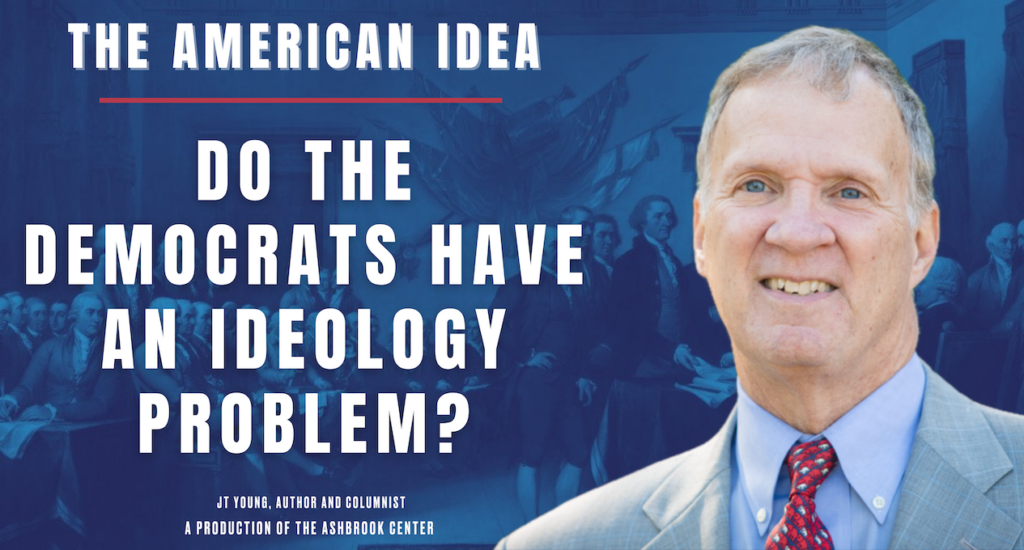Does the Democratic Party Have an Ideology Problem?
April 9, 2025

Listen and subscribe to the podcast
Join The American Idea’s Listener Email list – get news about upcoming episodes and a chance to offer questions for them, too!
The Democratic Party is undergoing a profound transformation that is reshaping American politics. Once a broad coalition spanning ideological divides, the party has increasingly concentrated toward the left, creating both opportunities and challenges for its electoral future. This shift reveals deeper tensions about the party’s identity, its relationship with working-class voters, and its strategy for building winning coalitions in a changing political landscape.
The Liberal Ascendancy
Today’s Democratic Party bears little resemblance to its Clinton-era incarnation. Polling data reveals that self-identified liberals now constitute 54% of the party—more than double their proportion from decades ago. This leftward migration represents a remarkable consolidation, especially considering liberals make up only about 23% of the broader American electorate.
The traditional geographic divisions that once defined American politics—Democrats in the South, Republicans in the North—have given way to ideological sorting. Democratic strongholds like Massachusetts aren’t simply products of regional history but represent populations whose worldviews align with the party’s progressive platform. While this ideological concentration has created a more coherent base, it has simultaneously distanced the party from the median American voter.
Rising Tensions: The New Left vs. Party Establishment
The emergence of the party’s far-left wing exemplifies its internal fracturing. Figures like Alexandria Ocasio-Cortez represent an ideological vanguard challenging traditional power structures. The speculation that AOC might primary Senate Minority Leader Chuck Schumer in 2028 signals a deeper generational and philosophical struggle for the party’s direction.
This internal conflict reflects broader tensions between economic populists and what critics call “coastal elites.” Bernie Sanders articulated this divide when suggesting the working class has abandoned Democrats because the party no longer champions their interests. Many working-class Democratic voters hold traditional social values and feel threatened by calls to dismantle existing systems. Meanwhile, moderate Democrats like Joe Manchin and Kyrsten Sinema have either departed politics or faced significant electoral challenges, further eroding the party’s ideological diversity.
The Myth of Demographic Destiny
Early this century, political commentators confidently predicted an “emerging Democratic majority” based on demographic trends, particularly growing support among minority groups and younger voters. The Obama administration’s victories seemed to validate this theory. However, subsequent elections—particularly those involving Donald Trump—have challenged these assumptions.
The 2024 election highlighted this reality when Trump won seven crucial swing states, demonstrating that demographic advantages don’t automatically translate to electoral victories. Most voters show signs of becoming more conservative as they age, and if exit and opinion polls over the last several months are accurate, it seems that Generation Z – those arguably hit hardest by Covid policy decisions – are more conservative than Millenials by a sizable degree. Democrats now face the reality that demographics aren’t destiny, that younger voters are already abandoning them, and that electoral success requires building coalitions beyond identity politics.
Finding a Path Forward
The Democratic Party confronts a strategic dilemma. Its traditional New Deal coalition in the South has largely collapsed, with once-reliable states shifting toward Republicans. While opportunities remain in states like North Carolina and Georgia, Democrats must fundamentally reconsider their electoral map.
The party’s overwhelming margins in California and New York provide significant popular vote advantages but limited electoral college benefit. To rebuild a viable presidential coalition, Democrats must reconnect with voters in swing states. Historically, leaders like Jimmy Carter and Bill Clinton emerged as moderates who could bridge factional divides within the party. However, today’s Democratic Party has shifted so far left that it’s difficult to imagine how such a unifying moderate could survive the primary process.
Democrats also face eroding support from traditionally reliable constituencies. The Jewish community has expressed growing concern about the party’s positions on Israel and antisemitism, particularly following recent Middle East events. This illustrates the central challenge: how can the party maintain its progressive base while appealing to centrist voters necessary for electoral victories?
As American politics continues to evolve, the Democratic Party’s future depends on resolving these tensions and forging a new coalition capable of winning in a changing landscape. Whether it can accomplish this transformation—or whether its internal contradictions will lead to further fragmentation—remains one of the most consequential questions in contemporary American politics.

